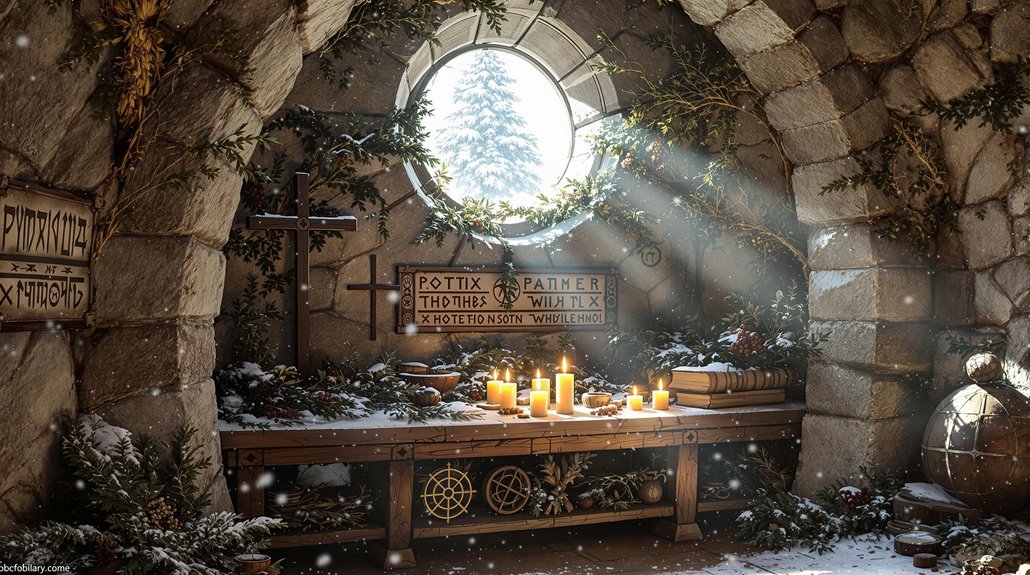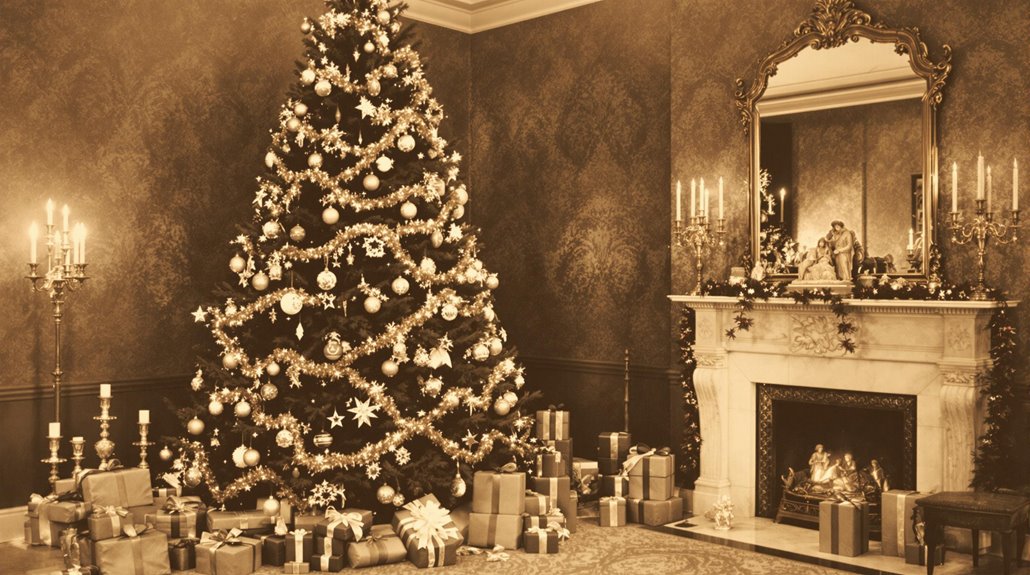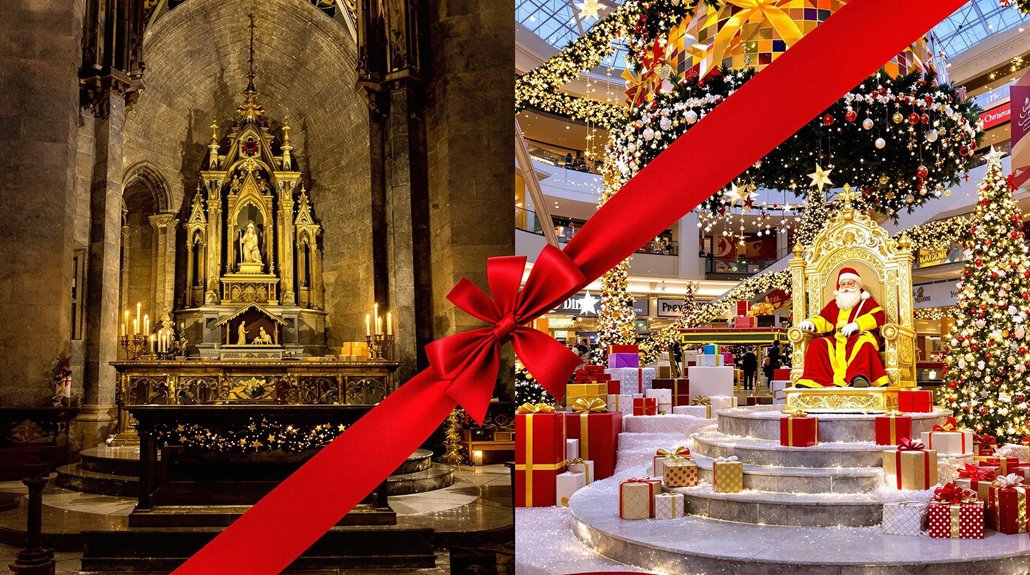Your modern Christmas celebration stems from an unlikely merger of ancient pagan festivals, religious tradition, and Victorian-era commerce. While December 25th originated from winter solstice celebrations like Roman Saturnalia, Christianity absorbed these customs to strengthen its influence. Today’s $1 trillion holiday industry has transformed spiritual observance into a consumer spectacle, with families spending $1,000 on gifts annually. Yet beneath the marketing manipulation lies a complex story of faith, culture, and calculated profit.
Ancient Winter Festivals: The Pagan Roots of Christmas

Before Christianity adopted December 25th as Christmas, ancient civilizations celebrated numerous winter festivals during the darkest days of the year.
You’ll find these solstice celebrations embedded in cultures from Rome to Scandinavia, each marking humanity’s enduring relationship with nature’s cycles.
The winter solstice, occurring around December 21st, sparked festivities that’d make modern holiday parties look tame.
You’re inheriting traditions from the Roman Saturnalia, where social hierarchies dissolved and gift-giving dominated the streets.
In Germanic regions, you’ll discover the roots of Yule, a 12-day feast that merged seamlessly with Christian customs.
The ancient Egyptians celebrated the rebirth of Ra, while Celtic Druids marked the solstice at sites like Stonehenge.
These pagan practices didn’t disappear – they evolved, adapting to Christianity’s expanding influence.
The Birth of Christ: Historical Records and Religious Significance
You’ll find that historical records of Jesus’s birth, while central to Christian tradition, reveal surprising inconsistencies between the Gospels of Matthew and Luke, the only biblical texts detailing the nativity story.
The exact year of Christ’s birth remains contested by scholars, with estimates ranging from 6-4 BCE based on historical markers like King Herod’s reign and the Roman census.
Despite these uncertainties, the religious and cultural significance of Jesus’s birth transformed Western civilization, establishing enduring Christmas traditions that billions now celebrate, merging historical fact with profound spiritual meaning.
Biblical Accounts and Sources
While modern Christmas celebrations center around festivities and gift-giving, the biblical accounts of Christ’s birth appear in just two of the four Gospels – Matthew and Luke.
These biblical manuscripts offer differing yet complementary perspectives, with Matthew focusing on Joseph’s viewpoint and the visit of the Magi, while Luke details Mary’s experience and the shepherds’ role.
You’ll find that early interpretations of these texts reveal fascinating disparities in how the nativity story was understood.
The Gospel of Mark, importantly, begins with Jesus’s adult ministry, while John takes a more theological approach.
Despite extensive analysis of existing manuscripts, scholars continue to debate the precise timeline and details of these accounts.
What’s clear is that these foundational texts have shaped two millennia of Christian tradition, even as you witness their narratives filtered through contemporary cultural lenses.
Dating Jesus’s Birth Year
Historical records reveal that Jesus’s birth year doesn’t align with our modern calendar system, despite its purported anchoring to this event. You’ll find that dating methods and scholarly interpretations point to a birth between 6-4 BCE, challenging traditional timelines.
| Evidence Type | Estimated Year | Key Indicators |
|---|---|---|
| Astronomical | 7-4 BCE | Star of Bethlehem |
| Historical | 6-4 BCE | Herod’s Death |
| Census Data | 6-5 BCE | Quirinius Record |
Calendar discrepancies emerged when 6th-century monk Dionysius Exiguus calculated Christ’s birth year, making critical errors in historical debates about the date. Modern analysis of astronomical events, including potential alignments of Jupiter and Saturn, suggests Jesus’s birth occurred earlier than previously thought. While the religious significance remains unchanged, you’re now witnessing a fascinating convergence of scientific investigation and historical scholarship that’s reshaping our understanding of this pivotal moment.
Cultural Impact and Traditions
Countless cultural traditions surrounding Christ’s birth have shaped global celebrations for nearly two millennia.
You’ll find holiday music filling city streets, while festive foods grace tables from Brazil to Bulgaria. Family gatherings have become the cornerstone of seasonal celebrations, combining ancient customs with modern cultural expressions.
Your local community events likely showcase the remarkable fusion of religious observance and winter solstice traditions, where seasonal decorations illuminate neighborhoods worldwide.
What’s particularly striking is how charitable giving peaks during December, with organizations reporting 30% of annual donations occurring in this single month.
You’re witnessing a phenomenon where sacred traditions merge with commercial interests, creating a complex tapestry of celebration that spans continents and crosses faith boundaries.
Medieval Christmas Customs and Religious Evolution
During the Middle Ages, Christmas transformed from a simple religious observance into an elaborate fusion of sacred rituals and pagan festivities.
You’ll find that medieval feasts became increasingly extravagant affairs, where lords and peasants alike participated in days-long celebrations that’d make modern office parties look tame.
Religious pageantry took center stage, with mystery plays and processions drawing crowds of thousands.
In the 12th century, you’d witness how the Church strategically absorbed local customs to strengthen its influence.
They’d incorporate traditional winter solstice practices into Christian ceremonies, creating a hybrid celebration that’d shape Christmas for centuries.
The period between December 25th and January 6th became known as Christmastide, when you’d see everything from solemn masses to wild revelry in the streets.
Victorian Era: Reshaping Modern Christmas Traditions

Britain’s Victorian era marked a revolutionary shift in Christmas celebrations, transforming medieval revelry into the commercialized holiday you’d recognize today.
Victorian innovations revolutionized how families celebrated, introducing Christmas cards in 1843 that turned seasonal greetings into a profitable industry. You’ll find the era’s influence in almost every modern tradition, from lavish festive feasts to mandatory family gatherings.
The period’s fascination with holiday decorations wasn’t just about aesthetics – it was big business. While religious revivals attempted to maintain Christmas’s sacred character, merchants capitalized on the growing market for ornaments, gifts, and festive goods.
You’re actually experiencing the direct legacy of this Victorian commodification every time you shop for presents or decorate your tree, participating in traditions that were fundamentally Victorian marketing innovations.
Santa Claus: From Saint Nicholas to Global Icon
Today’s Santa Claus represents one of history’s most calculated brand transformations, morphing from a humble 4th-century bishop into a global marketing powerhouse.
You’ll find his evolution intertwined with Holiday folklore across cultures, creating a universal symbol that transcends religious boundaries.
The Santa symbolism you know emerged through deliberate corporate decisions and cultural shifts:
- Coca-Cola’s 1930s ads standardized Santa’s red suit and jolly appearance
- Montgomery Ward created Rudolph in 1939 as a marketing campaign
- Hollywood amplified Santa’s mall presence through films like “Miracle on 34th Street”
- Global celebrations adapted local gift-givers into Santa-like figures
You’re witnessing a masterclass in Christmas marketing, where a religious figure’s transformation into a commercial icon reflects broader changes in how we celebrate the holidays.
Saint Nicholas would hardly recognize his modern incarnation.
The Rise of Christmas Consumerism
You might be shocked to learn that modern Christmas shopping, with its frenzied Black Friday sales, evolved from humble 19th-century department store promotions into today’s $1 trillion global retail phenomenon.
Your grandparents wouldn’t recognize the transformation of Saint Nicholas’s simple gift-giving tradition, which now drives nearly 20% of annual retail profits through aggressive marketing campaigns, doorbusters, and digital flash sales.
What began as children hanging stockings by the fireplace has mutated into a consumer-driven spectacle where the average American family spends $1,000 on gifts, while retailers weaponize nostalgia to fuel ever-increasing holiday sales targets.
Black Friday Shopping Evolution
Three decades of retail manipulation have transformed Black Friday from a simple post-Thanksgiving sale into a psychological warfare campaign against consumers’ wallets.
The Black Friday origins trace back to Philadelphia’s traffic chaos in the 1960s, but retailers have weaponized this shopping phenomenon into a masterclass of consumer manipulation.
You’ll notice today’s shopping trends have evolved into a complex matrix of:
- Pre-Black Friday “exclusive” deals starting weeks before
- Artificial scarcity through limited-time “doorbusters”
- Digital countdown timers creating urgency
- Strategic price inflation before “discounts”
You’re now faced with a retail landscape where Black Friday isn’t just a day – it’s a season.
Retailers have extended their tactics into Cyber Monday, creating a five-day spending marathon that’s designed to exhaust both your patience and your credit limit.
Gift-Giving Culture Takes Over
While Americans once celebrated Christmas through modest gift exchanges and religious observance, modern holiday spending has morphed into a $1 trillion consumer extravaganza that dominates the retail calendar.
You’ll find yourself caught in an endless cycle of commercial pressures, as retailers bombard you with “must-have” items and “door-buster” deals starting in October.
The transformation is stark. Your grandparents might’ve exchanged simple, often handmade gifts with immediate family.
Today, you’re expected to purchase presents for extended family, friends, coworkers, and even your children’s teachers.
Marketing experts estimate you’ll spend 30% more than you’ve budgeted, driven by flash sales and limited-time offers.
The result? The average American now carries $1,249 in holiday debt into the new year.
Cultural Diversity in Christmas Celebrations Worldwide
Despite sharing common themes of giving and celebration, Christmas traditions showcase remarkable diversity across continents and cultures.
You’ll find global variations that challenge the standardized Western narrative of Santa Claus and Christmas trees. In fact, festive customs differ dramatically from region to region, reflecting local values and historical influences, while multinational corporations scramble to adapt their marketing strategies accordingly.
Consider these distinct celebrations worldwide:
- In Japan, Kentucky Fried Chicken has become the traditional Christmas meal.
- Philippine families gather for Simbang Gabi, a nine-day series of dawn masses.
- Australian families often celebrate with beach barbecues in summer weather.
- Mexican communities observe Las Posadas, a nine-day religious commemoration.
You’re witnessing the remarkable adaptability of this holiday, as it merges with local traditions while maintaining its core message of hope and unity.
Balancing Spirituality and Secularism in Modern Christmas

As modern Christmas evolves into a complex intersection of faith and commerce, retailers and religious institutions engage in an unprecedented battle for cultural dominance.
Your experience of December now splits between spiritual reflections at candlelit services and frenzied shopping sprees at big-box stores.
You’ll notice how marketing campaigns increasingly co-opt religious imagery while churches adopt secular celebrations to stay relevant.
The average American spends $1,000 on Christmas gifts, while church attendance during the season has declined 23% since 2000.
You’re caught in the middle, maneuvering between midnight mass and midnight sales.
The solution isn’t choosing sides. Instead, you’ll find more meaning by consciously blending traditions: lighting advent candles before online shopping, or saying grace before opening presents.
Balance creates authenticity.
Conclusion
You’ve uncovered the complex tapestry of Christmas, where ancient paganism intertwines with Christian doctrine like holly wrapped around a sacred tree. Today’s reality blends devotion with door-buster sales, as marketing strategies shape your December traditions more than you might realize. Yet beneath the glossy veneer of commercialism, you’ll find the beating heart of celebration – whether spiritual or secular – that continues to unite communities worldwide.





